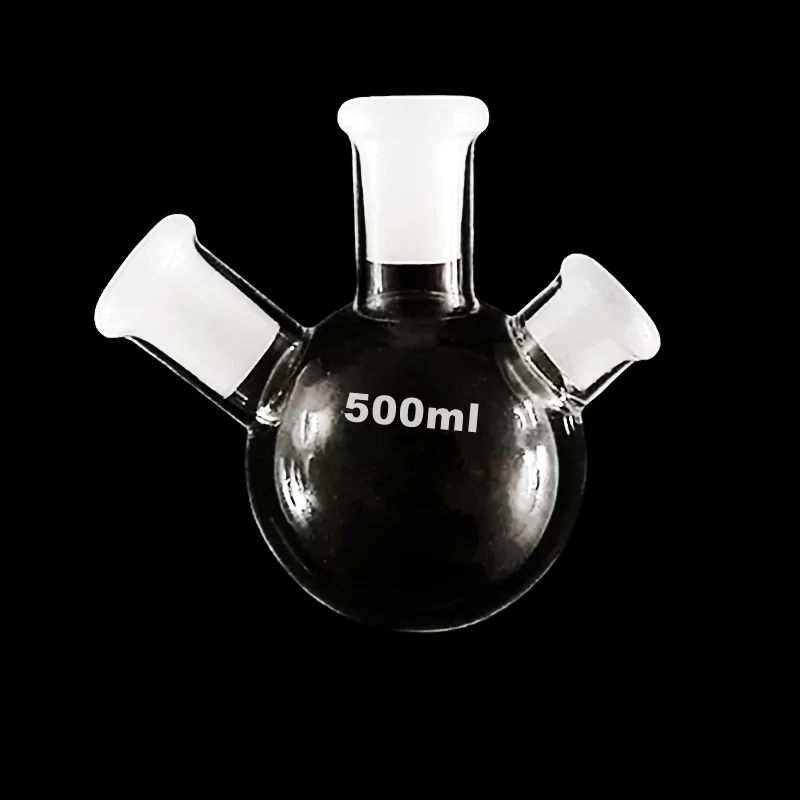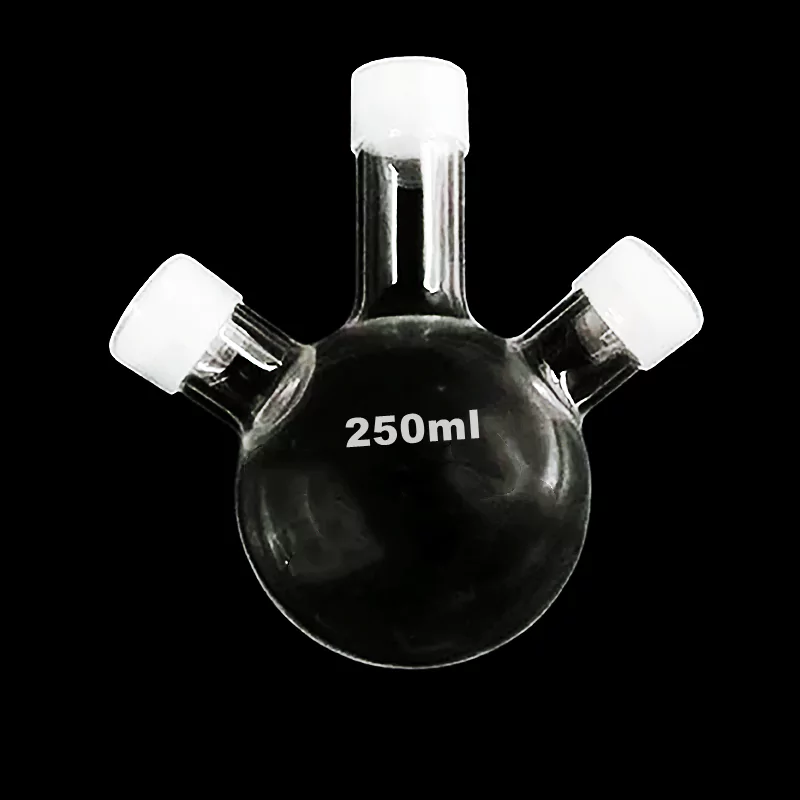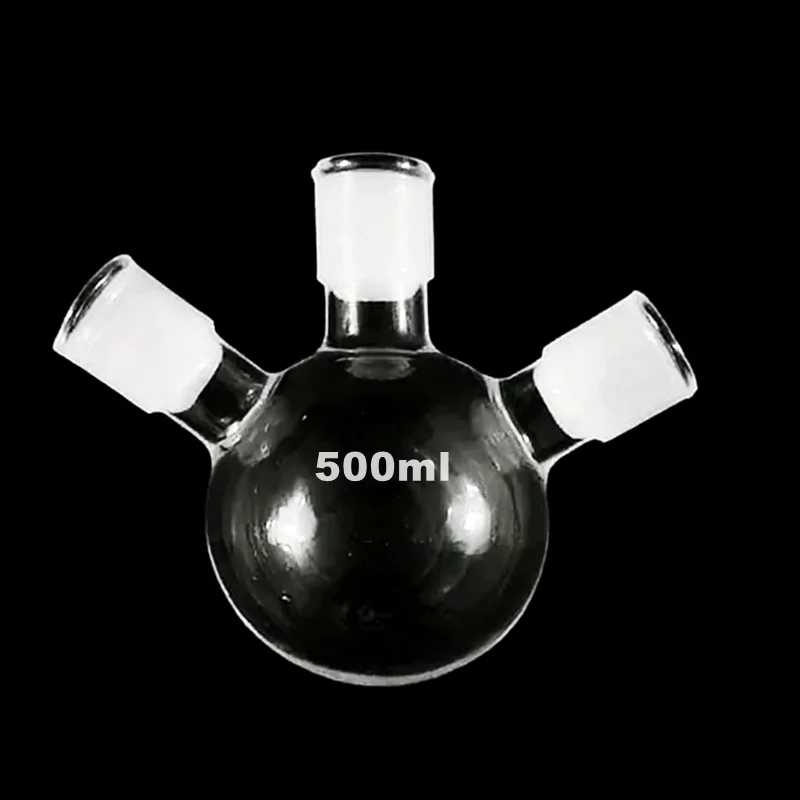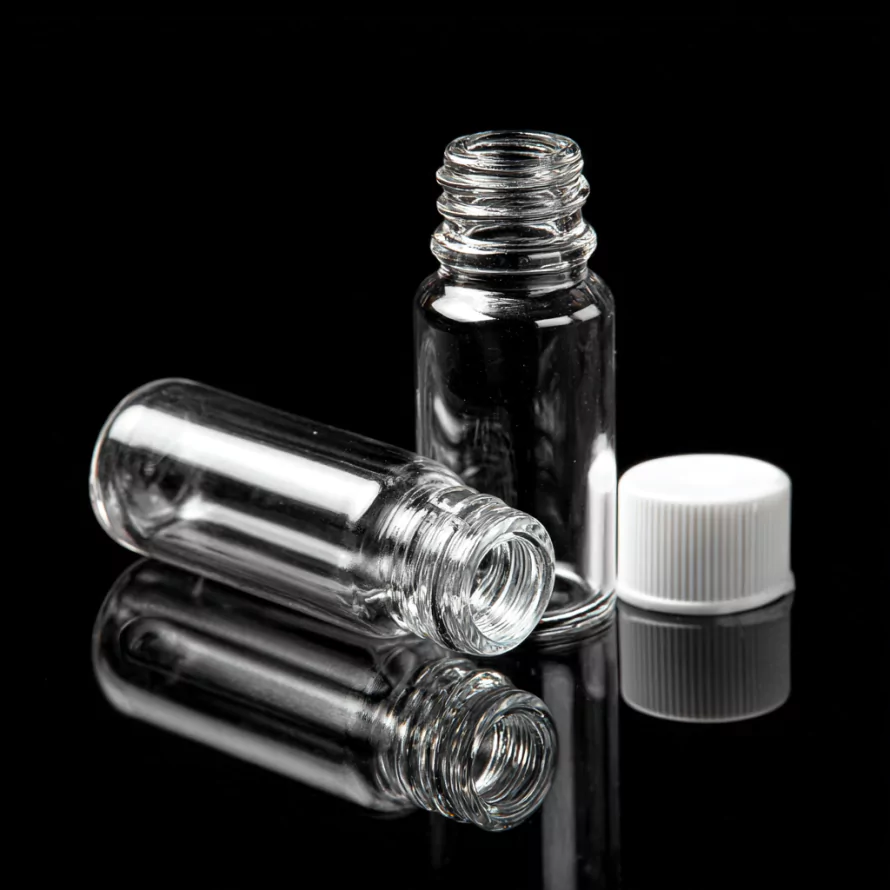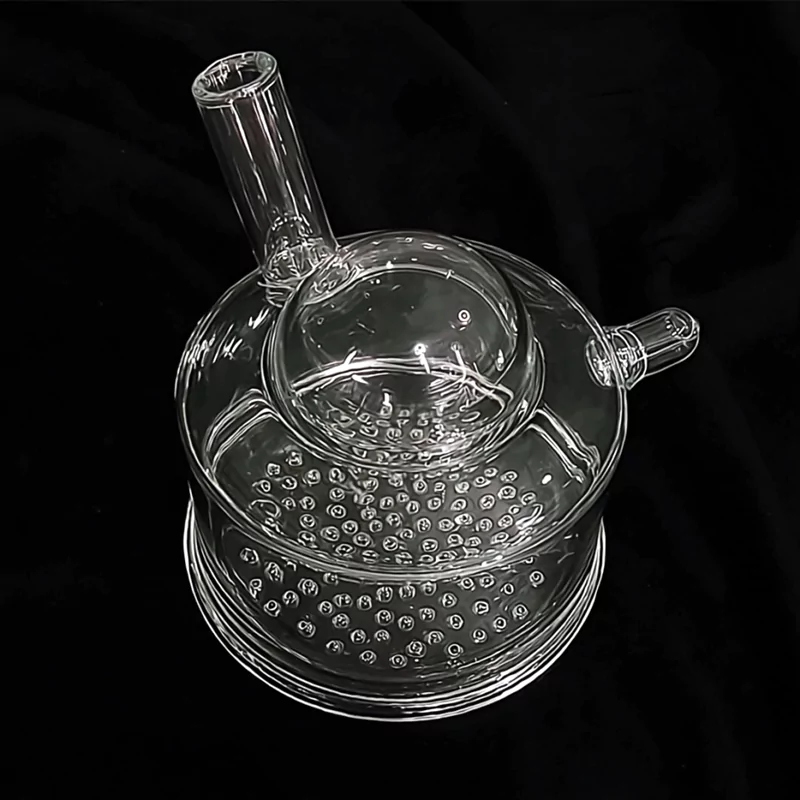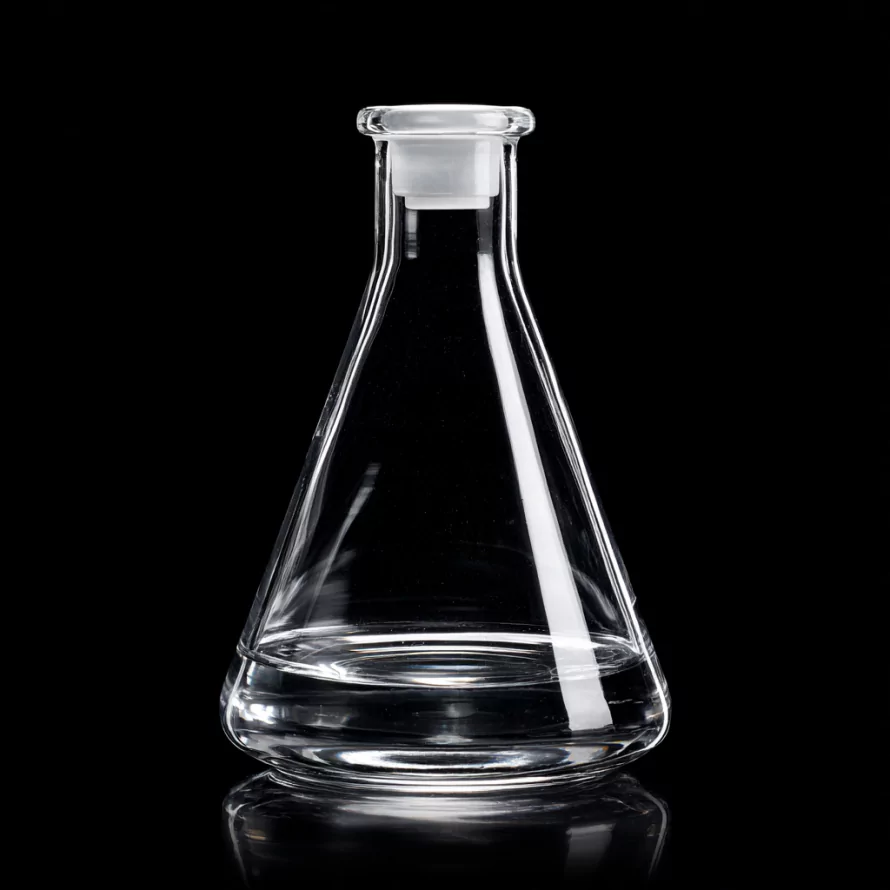- Home
- /
- Types
- /
- Quartz Bottle
- /
- Contamination-controlled Triple Neck Round...
Contamination-controlled Triple Neck Round Bottom Quartz Flask for Sensitive Experiments -TOQUARTZ®
Features of Triple Neck Round Bottom Quartz Flasks
Material Properties
- 99.99% SiO₂ purity fused quartz glass
- Fracture strength exceeding 350MPa
- Low thermal expansion coefficient: 5.5×10⁻⁷/°C
- High thermal conductivity: 120-160 W/m.K
Thermal Properties
- Maximum operating temperature: 1200°C
- Excellent thermal shock resistance
- Low coefficient of thermal expansion
- Withstands rapid temperature changes
Chemical Resistance
- Resistant to most acids including HF, HCl, H₂SO₄
- Stable against strong bases and alkaline solutions
- Unaffected by fluorinated gases
- Maintains integrity in molten salt environments

- Material: 99.99% SiO
- Temperature Resistance: Up to 1200°C
- Standard Joint Size: 24/29 ground glass joints
Technical Specifications & Dimensions of Quartz Glass Flask
Technical Specifications of Triple Neck Round Bottom Fused Quartz Flask
Physical Properties
| Property | Value |
| Density | 2.2 g/cm³ |
| Hardness (Mohs) | 5.5-6.5 |
| Tensile Strength | 48-51 MPa |
| Compressive Strength | 1100-1600 MPa |
| Thermal Conductivity | 1.4 W/m·K |
Chemical Properties
| Property | Value |
| SiO Content | ≥99.99% |
| Acid Resistance | Excellent (except HF) |
| Alkali Resistance | Good up to 1000°C |
| Chemical Inertness | Inert to most chemicals and reagents |
| Trace Element Impurities | <10 ppm total |
Dimensions of Round Bottom Quartz Flasks with Triple Neck
| Model | Capacity (ml) | Ground Joint Size | Diameter × Height (mm) | SiO2 Content(%) |
| AT-SY-SP1017 | 50 | 24/29 | 51*85 | 99.99 |
| AT-SY-SP1018 | 100 | 24/29 | 64*103 | 99.99 |
| AT-SY-SP1019 | 150 | 24/29 | 75*121 | 99.99 |
| AT-SY-SP1020 | 250 | 24/29 | 85*130 | 99.99 |
| AT-SY-SP1021 | 500 | 24/29 | 105*160 | 99.99 |
| AT-SY-SP1022 | 1000 | 24/29 | 131*187 | 99.99 |
| AT-SY-SP1023 | 2000 | 24/29 | 166*230 | 99.99 |
Enabling Complex Laboratory Workflows with TOQUARTZ® Triple Neck Round Bottom Quartz Flasks
Triple Neck Round Bottom Quartz Flask for Multi-Step Reaction Integration
Key Advantages
-
Supports uninterrupted multi-reagent workflows
Three necks allow simultaneous use of condenser, addition funnel, and thermometer without reconfiguration. -
Reduces setup time by up to 30% in sequential synthesis
Enables continuous reaction steps without disassembly or vessel transfer. -
Minimizes cross-contamination in complex reactions
Dedicated ports eliminate the need to swap devices mid-process, reducing exposure risk.
TOQUARTZ® solution
A mid-sized chemical equipment manufacturer in Poland reported inefficiencies in their pilot-scale synthesis setups due to limited flask connectivity. Their team had to pause reactions to switch between addition funnels and thermometers, increasing the risk of contamination and reducing throughput. After switching to TOQUARTZ® triple neck round bottom quartz flasks, they were able to run multi-step reactions continuously, reducing setup time by 30% and improving reproducibility across batches.
Triple Neck Round Bottom Quartz Glass Flask for Photochemical Reaction Monitoring
Key Advantages
-
≥93% visible light and ≥80% UV transmission at 254 nm
Quartz body ensures optimal light penetration for photochemical efficiency. -
Enables real-time monitoring without interrupting UV exposure
Separate necks allow simultaneous use of light source, probe, and sampling port. -
Improves photoreaction yield by up to 18% (based on lab trials)
Enhanced control over light input and reaction parameters boosts reproducibility.
TOQUARTZ® solution
A research group at a Canadian university working on UV-catalyzed organic synthesis faced challenges using standard glassware. Their double neck flasks could not accommodate both a UV light source and a temperature probe without compromising the light path. By adopting TOQUARTZ® triple neck round bottom quartz flasks, they achieved full-spectrum UV transmission and simultaneous monitoring, which improved reaction yields by 18% and reduced experimental variability.
Triple Neck Round Bottom Fused Quartz Flask for Gas-Liquid-Solid Phase Reactions
Key Advantages
-
Simultaneous gas inlet, stirring, and thermal control
Three-port design supports full integration of multi-phase reaction components. -
Maintains structural integrity in HF and fluorinated gas environments
99.99% SiO₂ quartz resists degradation in highly corrosive gas-phase systems. -
Reduces batch rejection rates by 22% in fluoropolymer synthesis
Improved phase control and vessel compatibility enhance product consistency.
TOQUARTZ® solution
A Japanese specialty materials company developing fluorinated polymers struggled with their gas-liquid-solid reaction setups. Using double neck flasks, they had to alternate between gas inlet and temperature monitoring, which led to unstable reaction conditions and inconsistent product quality. After switching to TOQUARTZ® triple neck round bottom quartz flasks, they achieved stable three-phase integration, reducing batch rejection rates by 22% and improving product consistency.
TOQUARTZ® Customization Services for Quartz Glass Flasks
· Equipment manufacturers integrating flasks into proprietary systems
· Chemical labs needing additional ports or modified neck angles
All custom Triple Neck Round Bottom Quartz Flasks are manufactured using 99.99% SiO₂ fused quartz and undergo strict dimensional and quality control.
Customization Options
TOQUARTZ® offer a wide range of customization capabilities to adapt the Triple Neck Round Bottom Quartz Flask to your exact requirements:
Neck Configuration
- Custom neck angles (e.g., 15°, 30°, 45°), additional necks (4 or 5), or repositioned side necks for specialized setups.
Joint Size & Type
- Standard 24/29 joints or alternative sizes (14/20, 19/22, 29/32, 34/45); spherical joints or custom ground joints available.
Flask Capacity
- Custom volumes from 50ml to 2000ml; intermediate sizes between standard models can be produced on request.
Additional Features
- Integration of side arms, sampling ports, fritted filters, thermowells, or vacuum take-off adapters.


Customization Process
TOQUARTZ®’s customization process is designed to ensure technical accuracy, fast turnaround, and full alignment with your application needs. Each step is optimized for B2B clients working with Triple Neck Round Bottom Quartz Flasks in demanding environments.
Requirement Consultation
- TOQUARTZ® engineers review your application scenario, including temperature, chemical exposure, and connection needs, to define the optimal Triple Neck Round Bottom Quartz Flask design.
Technical Drawing & Quotation
- We provide a detailed technical drawing (2D/3D) with all dimensions, tolerances, and joint specifications. A formal quotation is issued within 1–2 business days.
Prototype (Optional)
- For complex or high-value projects, we offer a prototype flask for validation before full production.
Production & Quality Control
- Custom Triple Neck Round Bottom Quartz Flasks are manufactured using high-purity fused quartz and inspected for dimensional accuracy (±0.2mm), joint fit, and surface integrity.
Usage Guidelines of Triple Neck Round Bottom Quartz Flasks
Proper handling, maintenance, and operation of quartz glass laboratory equipment ensures optimal performance and extended service life. Follow these guidelines to maximize the benefits of your TOQUARTZ triple neck round bottom quartz flasks.
How to Clean a Triple Neck Round Bottom Flask
- Remove any remaining contents and rinse with appropriate solvent.
- For general cleaning, use a solution of laboratory-grade detergent in warm water.
- For stubborn residues, use an appropriate solvent based on the contaminant (acetone, ethanol, etc.).
- For inorganic deposits, a dilute acid solution may be used (typically 10% nitric acid).
- Rinse thoroughly with deionized water multiple times.
- Avoid abrasive materials or brushes that could scratch the quartz surface.
- For precision cleaning, consider using an ultrasonic bath with appropriate solutions.
- Ensure all solvents and cleaning solutions are compatible with quartz glass.
How to Dry a Triple Neck Round Bottom Flask
- Rinse with acetone or ethanol to facilitate water removal, then air dry.
- For thorough drying, use a laboratory oven at 110-120°C for 1-2 hours.
- For moisture-sensitive applications, connect to a vacuum line and apply gentle heat.
- Verify dryness by visual inspection for any remaining moisture.
- When heating to dry, avoid rapid temperature changes that could cause thermal shock.
- For analytical work, rinse with the solvent to be used in the procedure before drying.
- Store immediately after drying to prevent contamination.
Safety Precautions for Triple Neck Round Bottom Flasks
- Always inspect for cracks or chips before use.
- Use appropriate clamping apparatus to secure the flask during reactions.
- When heating, use a heating mantle rather than direct flame.
- Avoid rapid temperature changes that can cause thermal shock.
- Fill to no more than 2/3 capacity when conducting reactions.
- Use proper PPE (gloves, goggles, lab coat) when handling.
- For pressure applications, ensure the flask is rated for the intended pressure.
- Never use damaged glassware under any circumstances.
How to Store Triple Neck Round Bottom Flasks
- Store cleaned and dried flasks in a dedicated cabinet away from heavy equipment.
- Use flask stands or specialized storage racks to prevent rolling and contact damage.
- For long-term storage, consider using original packaging or padded containers.
- Keep dust caps on ground joints to protect the precision surfaces.
- Avoid stacking flasks directly on top of each other.
- Store in a low-humidity environment when possible.
- Label storage locations to minimize handling during retrieval.
Need Engineering Support for
Your Triple Neck Round Bottom Quartz Flask Project?
and application-specific requirements for laboratory and industrial applications.
Why Partner with TOQUARTZ
Direct Factory Advantage
As a direct manufacturer, we can cut out the numerous intermediate links.
Engineering Expertise
Technical team guides clients from material selection to design optimization, translating specs into deliverables.
Flexible Manufacturing
Handling standard & custom orders via small-batch expertise and prototyping rigor to meet urgent deadlines.
Quality
Assurance
Pre-shipment 3-step validation:
1. dimensional accuracy,
2. material purity ,
3. performance thresholds
Global Supply Chain
Reliable global logistics to industrial hubs (DE/US/JP/KR priority) with trackable milestones.
Releted Products
As a specialized manufacturer with direct factory capabilities, TOQUARTZ provides both standard and custom quartz solutions with engineering support throughout the specification and implementation process.
FAQ
Q: What is a triple neck round bottom flask used for?
A: Triple neck round bottom quartz flasks are primarily used for complex chemical reactions that require multiple attachments. The three necks allow simultaneous connection of different apparatus such as condensers, addition funnels, thermometers, gas inlets, or stirring mechanisms. They’re especially valuable for reactions requiring controlled atmospheres, refluxing, distillation, and high-temperature synthesis where standard borosilicate glass cannot withstand the conditions.
Q: How do I select the right size triple neck round bottom quartz flask?
A: When selecting the right size triple neck quartz flask, consider the following factors: (1) Reaction volume – fill the flask only to 1/2 to 2/3 of its capacity to allow for expansion, stirring, and prevent spillage (2) Heat distribution – larger flasks may require more powerful heating equipment for uniform heating (3) Joint size compatibility – ensure the neck joint sizes match your existing condensers, thermometers, and other attachments (4) Laboratory setup – confirm the flask dimensions fit your heating mantles, stands, and clamps (5) Reaction type – exothermic reactions or those generating gas may require additional headspace
Q: Can standard ground joint accessories fit TOQUARTZ triple neck flasks?
A: Yes, TOQUARTZ triple neck quartz flasks feature standard ground joint dimensions (24/29 in our standard models) that are fully compatible with standard laboratory accessories. This includes condensers, addition funnels, thermometer adapters, stoppers, and other standard ground joint glassware from major laboratory suppliers. The joints are precision-ground to ensure proper sealing and compatibility. For specialized applications, we also offer custom joint sizes (14/20, 19/22, 29/32, etc.) upon request.
Q: How do I determine which neck configuration is best for my application?
A: To determine the optimal neck configuration for your application, consider: (1) Required attachments – list all accessories needed simultaneously (condenser, thermometer, addition funnel, gas inlet, etc.) (2) Neck angles – standard configurations have the center neck vertical with side necks at 20° angles; custom angles available for special setups (3) Neck position – consider ergonomics and space constraints in your laboratory setup (4) Neck diameters – match to the joint size of your existing equipment (standard 24/29 or custom sizes) (5) Specific process requirements – reflux reactions typically need a center neck for a condenser, while addition processes may require a larger side neck. Our technical team can provide consultation on optimal configurations based on your specific experimental needs and laboratory constraints.
Q: How does the purity of quartz affect experimental results?
A: The purity of quartz glass directly impacts experimental results in several ways: (1) Contamination prevention – high-purity quartz (99.99% SiO₂ as in TOQUARTZ products) minimizes leaching of metallic impurities into sensitive reactions (2) Spectroscopic interference – lower purity quartz may contain metal oxides that can interfere with spectroscopic measurements (3) Catalytic effects – impurities can potentially catalyze unwanted side reactions (4) Temperature resistance – higher purity quartz maintains its properties more reliably at extreme temperatures (5) UV/optical transmission – impurities can affect light transmission properties critical for photochemical reactions. For most standard laboratory applications, our 99.99% purity quartz is sufficient, while specialized applications requiring ultra-high purity should be discussed with our technical team.
Contact our engineering team for technical consultation and pricing. We’ll help you select the optimal specifications for your application requirements.


